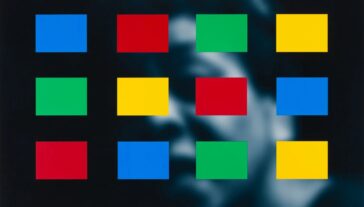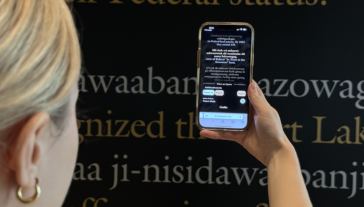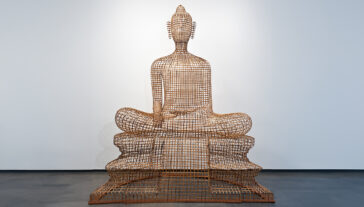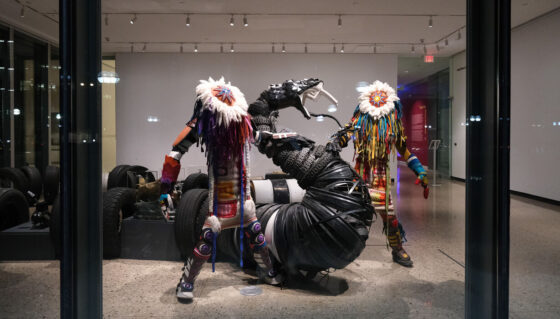Artist Cannupa Hanska Luger Paints “Gift” on UMMA’s Historic Facade in Early Hours of the Morning
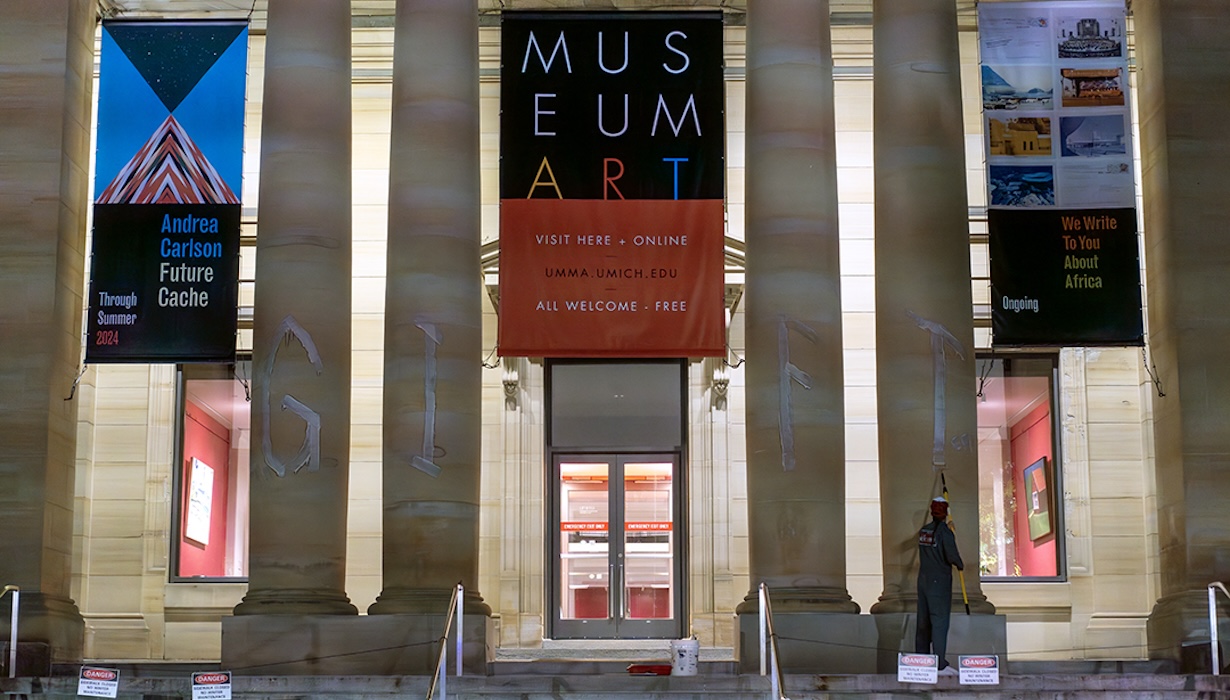
On September 22, the University of Michigan Museum of Art (UMMA) will open Cannupa Hanska Luger: You’re Welcome, a three-part project developed in collaboration with multidisciplinary artist Cannupa Hanska Luger (enrolled member of the Three Affiliated Tribes of Fort Berthold) and the nonprofit public art and history studio Monument Lab. You’re Welcome examines the history of the land on which the University of Michigan sits—and its relationship to broader dialogues about land sovereignty, colonialism, memorialization, and the cultural perspectives of and implications for Indigenous communities.
The project features a commissioned installation by Luger for the exterior of one of the museum’s buildings as well as an in-gallery exhibition that creates a dynamic interplay between several of the artist’s sculptural installations and works selected from UMMA’s expansive collection. The project also includes the Monument Lab: Public Classroom, which offers a space for dialogue and further contemplation of key themes within You’re Welcome, especially the central curatorial question: “How do we remember on this campus?”
Cannupa Hanska Luger: You’re Welcome is curated by Ozi Uduma, UMMA’s Assistant Curator of Global Contemporary Art, and Dr. Paul Farber, Director and Co-founder of Monument Lab and Curator in Residence for the University of Michigan Arts Initiative. It will remain on view through February 18, 2024.
At the core of You’re Welcome is Luger’s experimental, commissioned installation for the exterior of Alumni Memorial Hall, a neoclassical building that opened in 1910 to commemorate U-M students and staff who served in the Mexican American, Civil, and Spanish-American wars and is today one of UMMA’s two adjoined buildings. The installation, titled GIFT, takes its point of departure from the 1817 Treaty of Fort Meigs, in which it is stated that Ottawa, Chippewa, and Potawatomi tribes “gifted” land to the University, which used it to establish its endowments and create its campus. To explore the meaning of “gifting” within both the contexts of colonialism and Indigenous communities, Luger will paint the word “GIFT” in white porcelain clay slip on the columns of the building. In the days following, Luger and a team of collaborators will continue to paint around the letters, covering the entire historic facade with a layer of white clay and eventually covering the letters themselves. Eventually rain, wind, sun, and snow will interact with the clay slip, slowly removing it and returning it to the land. UMMA plans to capture the entire creation and degradation process in videos that will be available in the galleries and online.
With GIFT, Luger activates weather and time as co-conspirators, challenging perceptions of permanence in memory, history, and even physical structures. At the same time, the installation responds to dominant historic narratives, expanding our understanding of the “gift” beyond the lens of colonialism to embrace the meaning of gifting within Indigenous communities, where it signifies the giver’s success, abundance, and ability to offer something of value. In this way, GIFT prompts critical thinking about cultural perspectives and encourages more nuanced thinking about historic storytelling and mythmaking. UMMA is also implicated in this essential process, as museums stand as stewards of cultural history and heritage. The use of the white clay slip and its slow dissolution signifies an invitation to dismantle the existing white-centric structures that guide many museum practices.
“The stone of the building is sandstone from Ohio that was quarried and extracted, and rebuilt into a Greek and Romanesque story here in Michigan,” Luger said. “The architecture itself embeds a history into the campus that was never here. It is a monument to civilization and thought and enlightenment; but it is also an imposition and an extraction from the very land that we’re standing on. With GIFT, I want to do the same thing, present an imposition drawn from an extraction. Using Kaolin, a white clay from North America, I’m going to resurface the exterior of the Museum, presenting it as white as I think it is.
And then in cooperation and relationship with the environment, the weather will remove that thin exterior and re-expose the indigenous stone of the land.”
The in-gallery exhibition will feature Luger’s sculptural installation This is Not a Snake, made from riot gear, ceramics, fiber, steel, oil drums, concertina wire, ammunition cans, trash, beadwork, and other found objects. Luger, who was born and raised on the Standing Rock Indian Reservation, created the serpentine-like work following the 2016 Dakota Access Pipeline protests. At UMMA, the sculptural installation will interact with artworks from the museum’s collection, including Randolph Rogers’ Bust of George Washington after Jean-Antoine Houdon (1868); Thomas Eakins’ plaster relief, Small House-Skeleton (1878); Imogen Cunningham’s print Northwest Native (1934), and Pope L.’s installation Flint Water (12-pack) (2017), among others. The exhibition will also feature Luger’s The One Who Checks and The One Who Balances, an installation comprised of two defiant figures, dressed in futuristic regalia with beadwork by the artist’s mother, Kathy Elkwoman Whitman. Together, the works in the exhibition reflect on cultural destruction and displacement, especially as it relates to Indigenous communities. As with the exterior commission, the role of museums in collecting and presenting objects detached from their original contexts is questioned and examined.
“As we work together with our communities on creating relevant and meaningful artistic experiences, we necessarily need to examine how museums both produce and disseminate shared cultural history—both as it was once told and also as it is being retold today,” said Christina Olsen, UMMA’s Director. “Our collaboration with Cannupa Hanska Luger allows us to reshape the narrative of a building central to our museum and to our campus to reflect a broader, more nuanced, and more accurate history that embraces different perspectives and lifts up diverse cultural experiences.”
The Monument Lab: Public Classroom is the third element of the You’re Welcome project. This space offers a poetic exploration of memory and considers how memory has shaped and continues to shape the University’s campus. The classroom includes examples of personal, collective, ancestral, institutional, and speculative approaches to memory that visitors will be able to interact with and add their own perspectives. The space will also feature archival photographs of scenes within and nearby Alumni Memorial Hall, historic documents and books, an ambient soundscape remixing archival sounds from the University’s history, and ephemera from Luger’s GIFT.
“Working in collaboration with Cannupa Hanska Luger, UMMA, and the U-M Arts Initiative over the last several years has been incredibly meaningful, “ says Ozi Uduma and Paul Farber, co-curators. “You’re Welcome offers both a historical reflection and an open-air experiment with monumental architecture that pushes us to consider how we mark and measure the passing of time on land we now call the ‘campus.’”
More from UMMA
